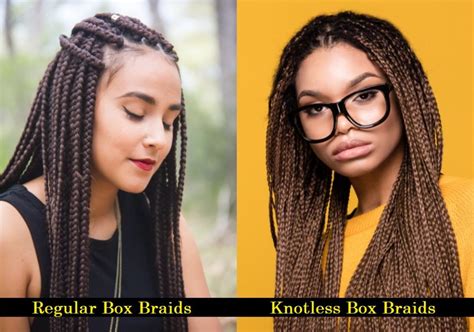Introduction
Braids have been an integral part of African culture for centuries. With time, they have evolved into various styles, two prominent ones being knotless and box braids. While they share some similarities, these braiding techniques offer distinct advantages and disadvantages. This comprehensive guide will delve into the key differences between knotless and box braids, providing insights to help you make an informed choice.

Knotless Braids vs. Box Braids: A Comprehensive Overview
1. Technique
Knotless Braids:
- Created by feeding the braiding hair directly onto your own hair without creating any knots.
- Uses an interlocking motion to secure the hair.
Box Braids:
- Involve creating small, square-shaped sections on the scalp.
- Braided by criss-crossing the hair over and under, creating a knotted appearance.
2. Appearance
Knotless Braids:
- Often appear more natural and seamless, as there are no visible knots.
- Have a tighter, sleeker look.
Box Braids:
- Characterized by a chunky, bulky appearance due to the knots.
- Offer more volume and definition.
3. Tension
Knotless Braids:
- Apply less tension to your natural hair, as the interlocking motion distributes the weight evenly.
- Ideal for those with sensitive scalps or prone to hair breakage.
Box Braids:
- Can put more strain on your hair due to the knots and tight braiding technique.
- Not suitable for individuals with fragile or damaged hair.
4. Comfort
Knotless Braids:
- Generally more comfortable to wear, especially when lying down or sleeping.
- Do not cause as much scalp irritation or discomfort.
Box Braids:
- May be less comfortable due to the tension and weight.
- Can lead to headaches or soreness in some individuals.
Advantages and Disadvantages of Knotless vs. Box Braids
| Feature | Knotless Braids | Box Braids |
|---|---|---|
| Appearance | Natural, seamless | Chunky, bulky |
| Tension | Low | High |
| Comfort | High | Moderate |
| Scalp Health | Better | May cause irritation |
| Time to Install | Longer | Shorter |
| Lifespan | 6-8 weeks | 4-6 weeks |
| Cost | More expensive | Less expensive |
Common Mistakes to Avoid
- Over-tightening: Both knotless and box braids can damage your hair if braided too tightly. Ensure the braider uses a gentle touch.
- Using damaged hair: Avoid braiding hair that is weak or brittle. This can lead to breakage and further damage.
- Neglecting maintenance: Regular washing and conditioning are essential for keeping your braids healthy and looking their best.
- Keeping braids in too long: Exceeding the recommended lifespan of braids can result in matting, tangles, and hair loss.
Why Knotless and Box Braids Matter
Braids are not just a hairstyle; they hold cultural significance and offer practical benefits.
- Cultural Identity: Braids have been a symbol of African identity and empowerment for centuries. They represent strength, beauty, and community.
- Hair Protection: Braids protect your natural hair from environmental damage, breakage, and tangles. They allow your hair to rest and grow without manipulation.
- Convenience: Braids are a low-maintenance hairstyle that can be styled in various ways. They are ideal for busy individuals who want to save time on their hair routine.
Conclusion
Ultimately, the choice between knotless and box braids depends on your personal preferences, hair type, and lifestyle. Knotless braids provide a more natural, comfortable, and protective experience, while box braids offer a bolder, voluminous look. By avoiding common mistakes and understanding the importance of braids, you can enjoy beautiful, healthy, and culturally significant hair.
